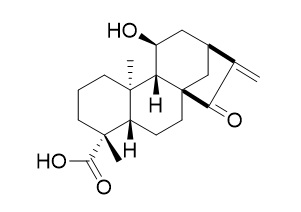ent-11alpha-Hydroxy-15-oxokaur-16-en-19-oic acid
Ent-11alpha-Hydroxy-15-oxokaur-16-en-19-oic acid has anti-cancer activity, it induces apoptosis of human malignant cancer cells, it also inhibits hepatocellular carcinoma in vitro and in vivo via stabilizing IkBα.
Inquire / Order:
manager@chemfaces.com
Technical Inquiries:
service@chemfaces.com
Tel:
+86-27-84237783
Fax:
+86-27-84254680
Address:
1 Building, No. 83, CheCheng Rd., Wuhan Economic and Technological Development Zone, Wuhan, Hubei 430056, PRC
Providing storage is as stated on the product vial and the vial is kept tightly sealed, the product can be stored for up to
24 months(2-8C).
Wherever possible, you should prepare and use solutions on the same day. However, if you need to make up stock solutions in advance, we recommend that you store the solution as aliquots in tightly sealed vials at -20C. Generally, these will be useable for up to two weeks. Before use, and prior to opening the vial we recommend that you allow your product to equilibrate to room temperature for at least 1 hour.
Need more advice on solubility, usage and handling? Please email to: service@chemfaces.com
The packaging of the product may have turned upside down during transportation, resulting in the natural compounds adhering to the neck or cap of the vial. take the vial out of its packaging and gently shake to let the compounds fall to the bottom of the vial. for liquid products, centrifuge at 200-500 RPM to gather the liquid at the bottom of the vial. try to avoid loss or contamination during handling.
University of Manitoba2023, 37433.
Molecules.2019, 25(1):E103
J Clin Med.2022, 11(13):3662.
Phytomedicine.2020, 79, 153351
Separations2021, 8(1), 1.
J Ethnopharmacol.2017, 196:75-83
Sci Rep.2023, 13(1):13610.
Separations2023, 10(7), 411.
Analytical Letters.2020, doi 10.1008
Molecules.2019, 24(24):E4536
Related and Featured Products
Invest New Drugs. 2012 Dec;30(6):2210-8.
Ent-11α-hydroxy-15-oxo-kaur-16-en-19-oic-acid inhibits hepatocellular carcinoma in vitro and in vivo via stabilizing IkBα.[Pubmed:
22227815 ]
ent-11alpha-Hydroxy-15-oxokaur-16-en-19-oic acid(5F) isolated from Pteris Semipinnata L is known to inhibit certain tumor cells in vitro. The information on the in vivo effect of 5F is limited and its effect on hepatocellular carcinoma (HCC) is unknown.
METHODS AND RESULTS:
In this study, the anti-tumor effect of 5F was investigated in a diethylnitrosamine (DEN)-induced mouse HCC model. In addition to therapeutic effect, the potential side effect was monitored. A panel of cultured HCC cells was used to confirm the in vivo data and explore the responsible molecular pathway. The result showed that 5F significantly inhibited the DEN-induced HCC tumors by reducing the number of tumor foci and the volume of tumors. Furthermore, 5F induced the death of cultured HCC cells in dose- and time-dependent manners. The cell death was confirmed to be apoptotic by in vivo and in vitro TUNEL assays. 5F inhibited NF-kB by stabilizing its inhibitor IkBα, reducing the nuclear p65 and inhibiting NF-kB activity. Subsequently it affected the NF-kB downstream molecules with a decrease in anti-apoptotic Bcl-2 and increase in pro-apoptotic Bax and Bak. During the whole period of the experiment, mice receiving 5F appeared to be healthy, though they suffered from a mild degree of hair loss. 5F did not damage liver and renal functions.
CONCLUSIONS:
In conclusion, 5F is effective against HCC with minimal side effects. It induces apoptosis in HCC cells via inhibiting NF-kB, leading to the decrease of Bcl-2 but the increase of Bax and Bak.
Curr Drug Targets. 2012 Dec;13(14):1730-7.
Ent-11α-hydroxy-15-oxo-kaur-16-en-19-oic-acid induces apoptosis of human malignant cancer cells.[Pubmed:
23140284]
ent-11alpha-Hydroxy-15-oxokaur-16-en-19-oic acid(5F) is a chemical compound isolated from Pteris semipinnata L (PsL), a Chinese traditional herb.
METHODS AND RESULTS:
5F has been known to exert antitumor activity in several kinds of human malignant cancer cells by leading cancer cell to apoptosis. 5F translocated Bax into the mitochondria, down-regulated Bcl-2, activated caspase-9 and caspase-3, released cytochrome c into the cytosol and translocated AIF from the mitochondria to the nucleus. The presentation of a wild-type p53 in the cancer cells facilitated cancer cells sensitive to the 5F treatment. 5F induces apoptosis of cancer cells by inhibiting NF-κB activation/induction, which leading to the decrease of Bcl-2 but the increase of Bax and Bak. MAPK kinases and Akt are also involved in process of 5F inducing cancer cell apoptosis. In lung cancer, 5F activated ERK1/2 and the inhibition of ERK1/2 suppressed 5F-mediated changes in apoptotic molecules. 5F activated Akt and suggested that Akt activation was anti-apoptotic rather than pro-apoptotic. However, in anaplastic thyroid carcinoma, JNK activation was related to cell death induced by 5F. ERK and p38 were also activated but as survival signals in response to 5F treatment to counteract the induction of cell death.
CONCLUSIONS:
Collectively, 5F is effective against several malignant cancers both in vivo and in vitro with minimal side effects. It induces apoptosis through the mitochondrialmediated pathway, in which regulation of Bcl-2 family proteins expression, the activation of MAPK and inactivation of NF-κB are critical. The good ability of 5F to inhibit cancer cells makes it in line with the successful development of other anti-tumor agents.



